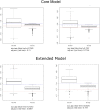Impact of a posttraumatic cerebral infarction on outcome in patients with TBI: the Italian multicenter cohort INCEPT study
- PMID: 32014041
- PMCID: PMC6998281
- DOI: 10.1186/s13054-020-2746-5
Impact of a posttraumatic cerebral infarction on outcome in patients with TBI: the Italian multicenter cohort INCEPT study
Abstract
Background: Post-traumatic cerebral infarction (PTCI) is common after traumatic brain injury (TBI). It is unclear what the occurrence of a PTCI is, how it impacts the long-term outcome, and whether it adds incremental prognostic value to established outcome predictors.
Methods: This was a prospective multicenter cohort study of moderate and severe TBI patients. The primary objective was to evaluate if PTCI was an independent risk factor for the 6-month outcome assessed with the Glasgow Outcome Scale (GOS). We also assessed the PTCI occurrence and if it adds incremental value to the International Mission for Prognosis and Clinical Trial design in TBI (IMPACT) core and extended models.
Results: We enrolled 143 patients, of whom 47 (32.9%) developed a PTCI. In the multiple ordered logistic regression, PTCI was retained in both the core and extended IMPACT models as an independent predictor of the GOS. The predictive performances increased significantly when PTCI was added to the IMPACT core model (AUC = 0.73, 95% C.I. 0.66-0.82; increased to AUC = 0.79, 95% CI 0.71-0.83, p = 0.0007) and extended model (AUC = 0.74, 95% C.I. 0.65-0.81 increased to AUC = 0.80, 95% C.I. 0.69-0.85; p = 0.00008). Patients with PTCI showed higher ICU mortality and 6-month mortality, whereas hospital mortality did not differ between the two groups.
Conclusions: PTCI is a common complication in patients suffering from a moderate or severe TBI and is an independent risk factor for long-term disability. The addition of PTCI to the IMPACT core and extended predictive models significantly increased their performance in predicting the GOS.
Trial registration: The present study was registered in ClinicalTrial.gov with the ID number NCT02430324.
Keywords: Disability; Long term outcome; Posttraumatic cerebral infarction; Traumatic brain injury.
Conflict of interest statement
The authors declare that they have no competing interests.
Figures




Similar articles
-
Posttraumatic cerebral infarction in severe traumatic brain injury: characteristics, risk factors and potential mechanisms.Acta Neurochir (Wien). 2015 Oct;157(10):1697-704. doi: 10.1007/s00701-015-2559-5. Epub 2015 Aug 27. Acta Neurochir (Wien). 2015. PMID: 26306582
-
Posttraumatic cerebral infarction: incidence, outcome, and risk factors.J Trauma. 2008 Apr;64(4):849-53. doi: 10.1097/TA.0b013e318160c08a. J Trauma. 2008. PMID: 18404047
-
Predicting outcome in patients with moderate to severe traumatic brain injury using electroencephalography.Crit Care. 2019 Dec 11;23(1):401. doi: 10.1186/s13054-019-2656-6. Crit Care. 2019. PMID: 31829226 Free PMC article.
-
Study Design Features Associated with Patient Attrition in Studies of Traumatic Brain Injury: A Systematic Review.J Neurotrauma. 2020 Sep 1;37(17):1845-1853. doi: 10.1089/neu.2020.7000. Epub 2020 May 14. J Neurotrauma. 2020. PMID: 32345119
-
Post-Traumatic Cerebral Infarction: A Narrative Review of Pathophysiology, Diagnosis, and Treatment.Neurol Int. 2024 Jan 4;16(1):95-112. doi: 10.3390/neurolint16010006. Neurol Int. 2024. PMID: 38251054 Free PMC article. Review.
Cited by
-
Risk Factors for Cerebral Infarction After Moderate or Severe Traumatic Brain Injury.Ther Clin Risk Manag. 2021 May 21;17:433-440. doi: 10.2147/TCRM.S309662. eCollection 2021. Ther Clin Risk Manag. 2021. PMID: 34054295 Free PMC article.
-
Long-Term Risk of Stroke after Traumatic Brain Injury: A Population-Based Medical Record Review Study.Neuroepidemiology. 2022;56(4):283-290. doi: 10.1159/000525111. Epub 2022 May 25. Neuroepidemiology. 2022. PMID: 35613548 Free PMC article.
-
Association Between Traumatic Brain Injury and Increased Risk of Stroke: A Systematic Review and Meta-analysis.J Head Trauma Rehabil. 2023 Jan-Feb 01;38(1):E44-E55. doi: 10.1097/HTR.0000000000000785. Epub 2022 May 26. J Head Trauma Rehabil. 2023. PMID: 36594863 Free PMC article.
-
Predictors of outcomes 3 to 12 months after traumatic brain injury: a systematic review and meta-analysis.Osong Public Health Res Perspect. 2024 Feb;15(1):3-17. doi: 10.24171/j.phrp.2023.0288. Epub 2024 Feb 5. Osong Public Health Res Perspect. 2024. PMID: 38481046 Free PMC article.
-
Early Experience With Artificial Intelligence Software to Detect Intracranial Occlusive Stroke in Trauma Patients.Cureus. 2024 Mar 27;16(3):e57084. doi: 10.7759/cureus.57084. eCollection 2024 Mar. Cureus. 2024. PMID: 38681375 Free PMC article.
References
Publication types
MeSH terms
Associated data
LinkOut - more resources
Full Text Sources
Medical

